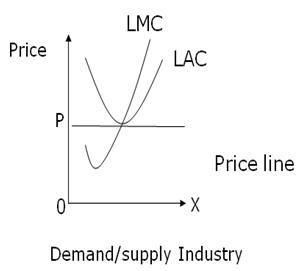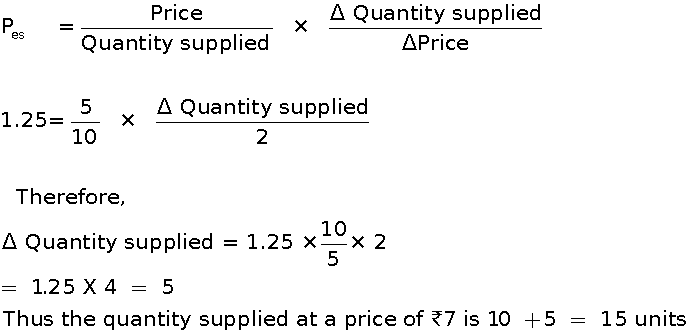Economics : 2013 : CBSE : [ All India ] : Set I
To Access the full content, Please Purchase
-
Q1
Define marginal revenue.
Marks:1View AnswerAnswer:
Marginal revenue (MR) is the additional revenue earned from the sale of an additional unit of a commodity or output.
Symbolically,

-
Q2
When is the demand for a good said to be perfectly inelastic?
Marks:1View AnswerAnswer:
When quantity demanded for a commodity does not change with response to change in its price, then the demand for that commodity is said to be perfectly inelastic i.e.

-
Q3
Give one reason for an “increase” in the supply of a commodity.
Marks:1View AnswerAnswer:
If there is an improvement in technology for a commodity with the price remaining same then it would lead to an increase in supply of a commodity by the producers.
-
Q4
What does rightward shift of demand curve indicate?
Marks:1View AnswerAnswer:
Rightward shift of demand curve indicates the increase in demand on account of the change in factors other than price of a commodity. The factors can be an increase in the price of a substitute commodity, favourable change in taste of a consumer, increase in the income of a consumer etc.
-
Q5
Under which market form is a firm a price taker?
Marks:1View AnswerAnswer:
Perfect competition is a form of market structure in which firm is a price taker.
-
Q6
Why is the demand curve of a firm under monopolistic competition more elastic than under monopoly? Explain.
Marks:3View AnswerAnswer:
Demand curve in monopolistic competition is more elastic than the demand curve in monopoly. The difference in the elasticity is due to the fact that under monopolistic competition there are more close substitutes available for the product as compared to monopoly, as monopolist is a single seller and there are no close substitutes available for the product. As a result the demand curve is less responsive to the changes in price in monopoly where as in monopolistic competition demand curve is more responsive to the changes in price.
Thus, we can say that demand curve is more elastic in monopolistic competition than in monopoly.

-
Q7
Why can a firm not earn abnormal profits under perfect competition in the long run? Explain.
Marks:3View AnswerAnswer:
Under perfect competition firms can not earn abnormal profits in the long run. If the firms are making abnormal profits i.e. price > minimum of the average cost curve then this situation would attract new firms in the industry. More firms mean more supply of a commodity which would lead to a fall in its price. Moreover there would also be an increase in the demand for factors which indicate higher factor prices and thus leading to higher average cost curve.
Fall in the price of a commodity and higher average cost of production would lead to a fall in abnormal profits. It would keep on falling until all the abnormal profits are not wiped out and the economy reaches at a minimum of average cost curve. Thus in the long run, firms under perfect competition earn no abnormal profits rather than earn zero normal profits.

-
Q8
Given the following table find out the level of output at which the producer will be in equilibrium. Give reasons for your answers.
Output
Marginal revenue
Marginal cost
1
8
10
2
8
8
3
8
7
4
8
8
5
8
9
Marks:3View AnswerAnswer:
Producer’s equilibrium is attained when the following conditions are achieved:
1. Marginal revenue = marginal cost
2.Marginal cost must be increasing.
Output MR MC 1 8 10 2 8 8 3 8 7 4 8 8 5 8 9 We can see in the above table that our first condition is fulfilled at 2nd and 4th level of output where
MR=MC= 8
But our second condition i.e. MC must be rising is only fulfilled at the 4th level of output. At the 2nd level of output MC is falling from 8 to 7 where as at the 4th level of output MC is rising from 8 to 9.Thus we can say that our producer’s equilibrium is achieved at the 4th level of output as both of our conditions are fulfilled at this level of output.
-
Q9
How is the demand for a good affected by a rise in the prices of other goods? Explain.
Marks:3View AnswerAnswer:
There are two aspects when the demand for a good is affected with the change in the price of other goods.
1.In the case of substitute goods, a rise in the price of substitute good would lead to increase in demand for a good as there exists a direct relationship between the demand for a given commodity and the price of its substitute good.
Substitute goods are those goods which can be used in place of another good to satisfy a given want. If the price of good increases then demand for that good would fall as it reduces the purchasing power of income and thus a rational consumer would demand more of a given amount of substitute good.
Example Tea and coffee are substitute goods. If prices of tea rise then demand for tea would fall and demand for coffee would increase.
2. In case of complementary good, if the price of a complementary good rises then the demand for a given commodity would decrease as there exists an inverse relationship between the price of a complementary good and demand for a given commodity.
Complementary goods are those goods which are utilized together and can’t be used in the absence of the other. If the price of a good increases then demand for that good would fall due to the law of demand and thus demand for complementary good would also fall.
Example. Car and petrol are complementary goods. If prices of petrol would increase then demand for car would also fall.
-
Q10
A firm supplies 10 units of a good at a price of
 5 per unit. Price elasticity of supply is 1.25. What quantity will the firm supply at a price of
5 per unit. Price elasticity of supply is 1.25. What quantity will the firm supply at a price of  7 per unit?Marks:3View Answer
7 per unit?Marks:3View AnswerAnswer:
Given, price elasticity of supply(pes) = 1.25
Quantity supplied = 10 units
Price = 5
New price = 7
∆ Price = 7
 - 5
- 5  =
=  2
2Now applying formula




